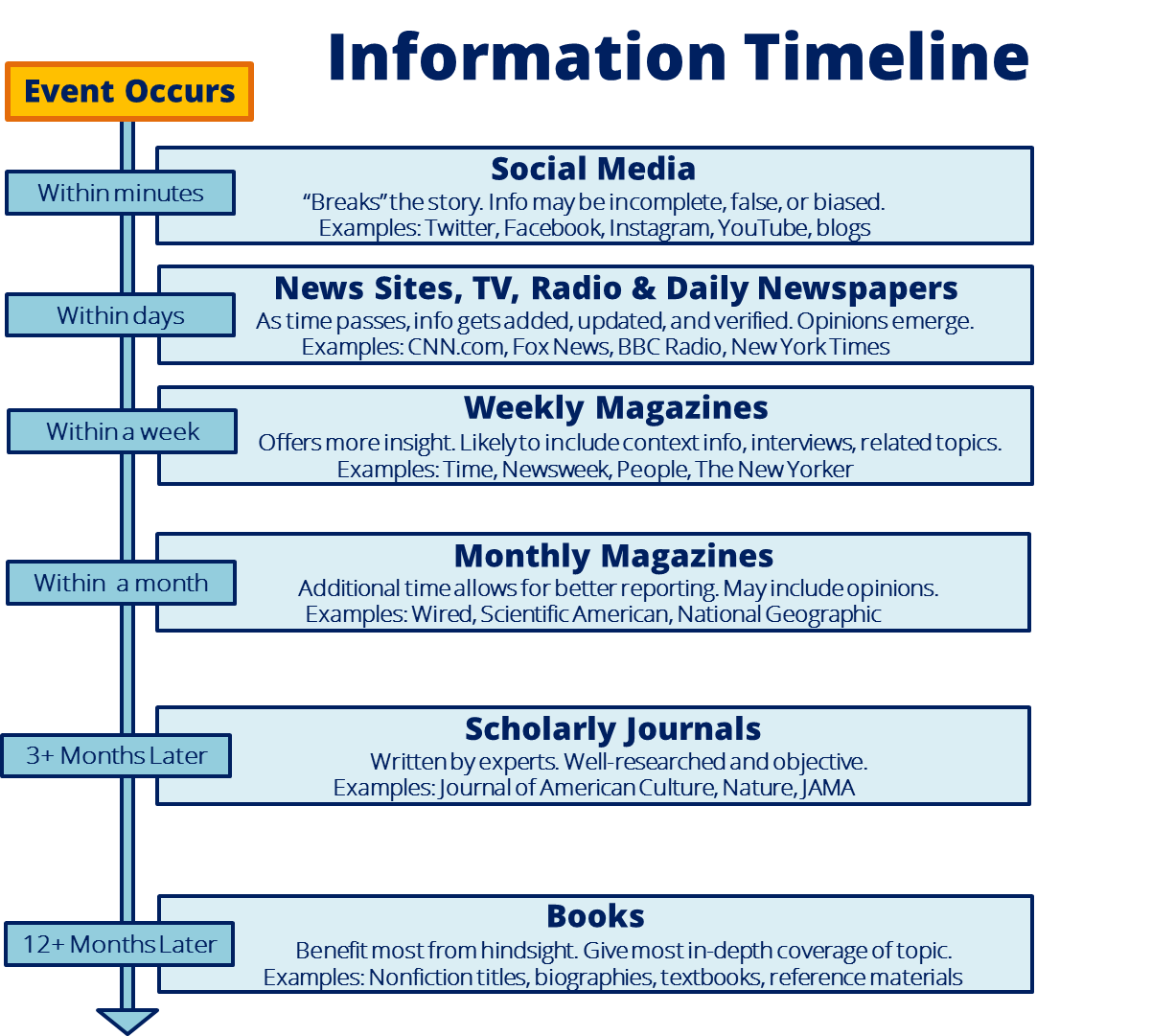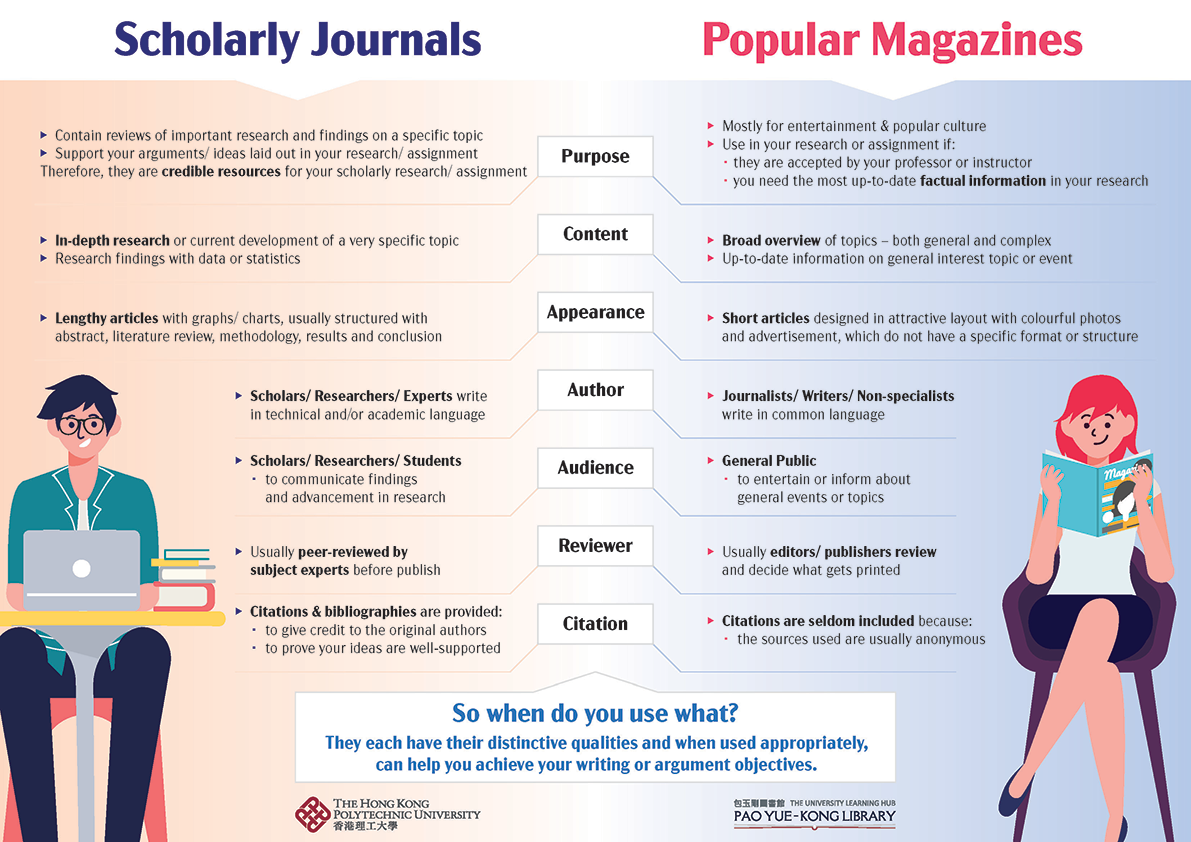- Common Source Types
- Information Cycle
- Primary v. Secondary
- Popular v. Scholarly
NOTE for users of screen readers: The collection of tabs above, while presented as a list, is clickable. Navigate to the list item you want, and press space to activate that tab.
Once you have a research question, you need information sources to answer it. Your sources should also address the following information needs:
- Include background information to help you learn more about your topic.
- Help you describe the situation surrounding your research question to your audience and explain why its important.
- Provide evidence to support your point of view and convince your audience that your answer is correct or the most reasonable one.
- Report what others have said about your research question, including any different answers.
The types of sources that you use will depend on your assignment as well as your topic. Ask yourself questions such as:
- Do I need background information?
- Do I need a quick reference or specific fact?
- Do I need a general overview?
- Does my topic lend itself to popular sources such as magazines or do I need scholarly journal articles?
- Do I need evidence to support my point of view?
- Do I need a firsthand account?
- Do I need the most current information available?
Once you determine what information you need, you're ready to select the types of sources that best fit your need. The following table describes the most common source types.
Types of Information Sources
| Source Type |
Disadvantages |
Best for... |
Encyclopedias
Encyclopedias contain brief overviews or summaries on a given topic. A typical article includes definitions, background information, key ideas, facts and statistics. The authors are experts in their field of study. General encyclopedias cover a broad range of topics while subject encyclopedias provide more comprehensive coverage in a specific field. |
Because they mostly repeat established, factual information, encyclopedias should not be cited in a college research paper, unless directly quoted. |
Good place to start if you know very little about a topic
Background information
Key ideas, facts, dates and concepts
References to other relevant sources |
Books
Books provide in-depth coverage on a given topic. They can be written for a range of readers, from general audiences to scholars. Academic books written by scholars always contain a bibliography of sources referenced in the book. |
Not as current as other sources
Not conducive to quick overview |
Background information
Broad overview of topic or event
Background and historical information
References to other relevant sources |
Magazines
Magazines contain articles on topics of popular interest and current events. Articles are geared toward a general audience and are written by staff writers or reporters (usually not subject experts) who may or may not cite their sources. Magazines are usually published on a weekly or monthly basis. |
Articles not always written by subject experts
Include varying points of view and opinions which require evaluation
No references |
General information written for non-experts or the general public
Timely information or opinions on current issues or popular culture
Information on people in the news |
Newspapers
Newspapers provide up-to-date information on the latest developments on various issues or current events. Coverage can be local, regional, national and international. Articles are written by staff writers or reporters. Some articles contain factual information while others are opinion-based. Newspapers are usually published daily or weekly. |
Articles often focus on relevant facts rather than big picture
Ongoing stories may not be reported consistently, leaving gaps in information
Information may be biased |
Breaking news
Information on local issues or events
Expert and popular opinions (e.g., editorials and other opinion pieces)
Older newspapers provide a historical perspective |
Academic/Scholarly Journals
Journal articles are written by experts in a field for other experts. They provide in-depth research on very specific topics. Some journals are peer reviewed, meaning the articles have been vetted by other scholars for quality and importance. Journals are typically published on a monthly or quarterly basis. |
Contain specialized jargon difficult for non-experts to understand
Focus of article may be too narrow for general research needs |
Authoritative, in-depth information
Evidence
Learn what professionals are writing and publishing about your topic
References to other scholarly sources |
Web Sites
Web browsers offer access to content that is freely available on the internet including web pages, blogs, social media sites, images, videos and sound files. Digital copies of the source types listed above may be available as well. |
Since anyone can publish on the internet, websites vary in terms of the quality of information they offer. You must carefully evaluate what you find. |
Up-to-the-minute information
Government publications
Company information
Expert and popular opinions |
"Sources and information needs" adapted from Sources and Information Needs, by Teaching & Learning, Ohio State University Libraries, licensed under a CC BY 4.0 license. "Types of information sources" adapted from Choosing & Using Sources: A Guide to Academic Research, created by Teaching & Learning, Ohio State University Libraries under a CC BY 4.0 license; and Types of Information Sources, created by LaChance Library, Mount Wachusett Community College (used with permission).
The information cycle refers to the way that information is produced and distributed and how it changes over time, from instant, up-to-date posts on social media to a broader, more thorough analysis in books and journals. Understanding how this process works can help you identify reliable and available sources.
After an event occurs, information about it becomes available in a pattern similar to this:
WITHIN MINUTES: Social media. Information may be incomplete, false, or biased. Examples: Twitter, Facebook, Instagram, YouTube, blogs.
WITHIN DAYS: News sites, TV, radio and daily newspapers. Information gets added, updated and verified. Opinions emerge. Examples: CNN.com, Fox News, BBC Radio, New York Times.
WITHIN A WEEK: Weekly Magazines. Offers more insight. Likely to include context information, interviews, related topics. Examples: Time, Newsweek, People, The New Yorker.
WITHIN A MONTH: Monthly Magazines. Additional time allows for better reporting. May include opinions. Examples: Wired, Scientific American, National Geographic.
3+ MONTHS LATER: Scholarly Journals. Written by experts. Well-researched and objective. Examples: Journal of American Culture, Nature, JAMA.
12+ MONTHS LATER: Books. Benefit most from hindsight. Give most in-depth coverage of topic. Examples: Nonfiction titles, biographies, textbooks, reference materials.

Information Timeline by adstarkel, licensed under a CC BY-NC-SA 2.0 license.
VIDEO: The Information Cycle (Darrell W. Krueger Library, Winona State University)
Sources can also be classified depending on whether the information is firsthand or secondhand.
Primary sources contain firsthand information on a topic from people who had a direct connection with it. Examples include an eyewitness account of an event, or the results of an experiment or scholarly research study written by the person(s) who conducted it.
Examples of primary sources:
- speeches
- diaries or journals
- correspondence such as letters, texts, or email messages
- interviews
- autobiographies
- live performances
- social media posts
- records of organizations and governmental agencies
- photographs, artwork, or other visual artifacts
- literary works such as stories, poems, or novels
- statistical data
- government documents
- legal documents
- scholarly journal articles in which the author(s) present the results of their own original research/experiments
Secondary sources are written by people who weren’t directly involved. A secondary source explains or interprets the data or events described in a primary source. Since they are one or more steps removed from the original event, secondary sources are considered less reliable in terms of evidence. Books and magazine/newspaper articles that mainly summarize or synthesize other people’s research are examples of secondary sources.
Examples:
- An experiment to determine the effectiveness of drug X in treating cancer is a primary source. A journal article presenting the results of the experiment, written by the researcher who conducted it, is also a primary source. A magazine article discussing the ability of drug X to treat cancer is a secondary source.
- Anne Frank’s diary is a primary source. A book analyzing or explaining the events described in her diary are secondary sources.
- The results of an opinion poll is a primary source. A newspaper article interpreting the results is a secondary source.
Primary sources provide firsthand information about your topic and credible evidence for your arguments.
Secondary sources provide background information and help you support your point of view with other researchers’ ideas.
WHEN IS A SECONDARY SOURCE A PRIMARY SOURCE?
Whether something is a primary or secondary source depends on how you use it.
Examples:
- If you are researching Martin Scorsese, a newspaper review of a movie he directed is a secondary source. But if you are researching critical responses to his work, the review is a primary source because it’s a firsthand example.
- If you are writing a paper on the war in Ukraine, a magazine article is a secondary source because it only summarizes information obtained from primary sources. But if your focus is on media coverage of the war, it is a primary source.
VIDEO: What are Primary and Secondary Sources? (University of Houston Libraries)
Sources can also be categorized by their intended audience.
Popular sources such as magazines and newspapers are written for the general public. Examples: People, Prevention, Discover, Rolling Stone, Sports Illustrated, National Geographic, Popular Mechanics, Omaha World-Herald, New York Times.
Scholarly sources such as scholarly journals are meant for scholars or professionals in a specific field. Scholarly journal articles are written by researchers or scholars to share new knowledge and further understanding in their field of study. Examples: American Journal of Botany, Critical Perspectives on Accounting, College English, Journal of Applied Philosophy, Nebraska Law Review, New England Journal of Medicine.
- Popular sources help you build an understanding of a topic.
- Scholarly sources help you develop an academic argument for your research.
Understanding the characteristics and differences between scholarly journals and popular magazines will help you evaluate and select the best information source.

Scholarly Journals vs Popular Magazines created by Pao Yue-kong Library, The Hong Kong Polytechnic University under a CC BY-NC 4.0 license.
Scholarly Journals vs. Popular Magazines
| Scholarly Journals |
Popular Magazines |
| Purpose |
Contains reviews of important research and findings on a specific topic
Support your arguments/ideas laid out in your research/assignment
Therefore, they are credible resources for your scholarly research/assignment |
Mostly for entertainment & popular culture
Use in your research or assignment if:
they are accepted by your professor or instructor
you need the most up-to-date factual information in your research |
| Content |
In-depth research or current development of a very specific topic
Research findings with data or statistics |
Broad overview of topics – both general and complex
Up-to-date information on general interest topic or event |
| Appearance |
Lengthy articles with graphs/charts, usually structured with abstact, literature review, methodology, results and conclusion |
Short articles designed in attractive layout with colorful photos and advertisement, which do not have a specific format or structure |
| Author |
Scholars/Researchers/Experts write in technical and/or academic language |
Journalists/Writers/Non-specialists write in common language |
| Audience |
Scholars/Researchers/Students
to communicate findings and advancement in research |
General Public
to entertain or inform about general events or topics |
| Reviewer |
Usually peer-reviewed by experts before published |
Usually editors/publish review and decide what gets printed |
| Citation |
Citations and bibliographies are provided:
to give credit to the original authors
to prove ideas are well-supported |
Citations are seldom included because:
the sources used are usually anonymous |
VIDEO: Scholarly vs Popular Sources (McMaster Libraries, McMaster University)
VIDEO: Peer Review in 3 Minutes (NC State University Libraries)
Watch this video lo learn more about the peer review process.